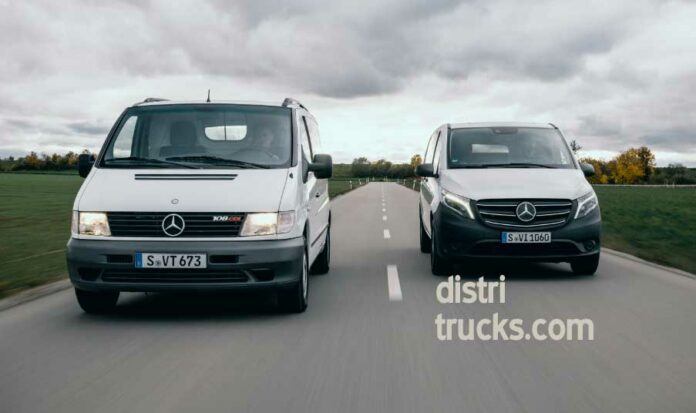The Mercedes‑Benz Vito is turning 30. Since its premiere in 1995, the midsize van was developed into a state-of-the-art midsize van. To establish its success, Mercedes had to overcome initial problems: the first generation was known for its notorious rust problems.
Despite the complaints from disappointed early customers, Mercedes-Benz managed to develop the Vito into a reliable vehicle. The Vito even achieved technical breakthroughs in the commercial van field, e.g. an electrically powered version was sold as early as 2010.
1995: First generation Mercedes-Benz Vito with transversely mounted four-cylinder diesel and gasoline engines
With the first generation of the Vito, Mercedes‑Benz presented a new van in the 2.6 to 2.8-ton class. The front-wheel drive model combined attractive design with compact dimensions and a payload of up to one ton. Thanks to its compactness and a vehicle height of 1.89 meters, the Vito fitted into inner-city parking garages, which was an important selling point.
In addition, the first generation offered a safety package as standard equipment, including a driver’s airbag, independent suspension and disc brakes on all wheels, ABS with automatic braking differential, and power steering.
Transversely mounted four-cylinder diesel and gasoline engines provided the power. Mercedes-Benz had sold a total of around 473,000 Vito’s by 2003.
2003: Second generation with rear wheel drive
For the second generation of the Vito, the entire vehicle concept was fundamentally revised: From then on, all variants of the midsize van were equipped with rear-wheel drive (or optional 4×4). The maximum payload rose to 1,295 kilograms.
The more powerful engine range extended from four-cylinder engines to V6 units. The Vito became available with three body lengths and two roof heights. By 2014, almost 750,000 second-generation Vitos had been sold worldwide.
The second generation also marked a milestone in electrification: In 2010, Mercedes-Benz launched the Vito E-Cell, a battery-electric van with a 70 kW (95 hp) electric motor, in small series production. The vehicle had a range of approximately 130 kilometers. Mercedes was not the first, but the E-Cell can be considered a milestone in van development.
2014: Third generation with new design, more space
The third generation of the Vito kicked off in 2014. More versatile, safer, and more economical, the new all-rounder among midsize vans featured a new design and three drive concepts: front-wheel, rear-wheel, or all-wheel drive. With the wheelbase unchanged, the Vito grew by up to 13 centimeters in length to a maximum of 5.37 meters. The max. payload increased to up to 1,369 kilograms.
The eVito, the first series-produced fully electric midsize van from Mercedes-Benz, followed in 2018. The Vito also set new standards in terms of safety, with airbags and seat belt reminders for the driver and passengers in the front passenger seat as standard. Crosswind Assist was also included as standard equipment.
In 2020, an update brought more innovations: The new OM 654 four-cylinder diesel engine family delivered greater power with lower fuel consumption. Added to this were the 9G-TRONIC automatic transmission, an optional digital interior mirror display, the automatic distance assistant DISTRONIC, other improved assistance systems and new (optional) comfort features such as the AIRMATIC air suspension. The luxury was not for everyone: some options were extremely expensive.
2024: The current Vito
Last year saw the next enhancement. The MBUX multimedia system introduced infotainment, improved connectivity, and new digital extras into the Vito.
The safety features were improved and expanded, including Active Brake Assist with Cross-Traffic Function and Active Lane Keeping Assist. The standard equipment was upgraded. For the first time, a gasoline engine with hybrid technology complements the range of drive options.
Manufactured in Spain
The MB Vito is manufactured at the plant in Vitoria-Gasteiz (Spain) – from which the Vito’s name also derives. The plant is one of Mercedes‑Benz Vans’ most important production sites and is the second-largest van plant in the Mercedes‑Benz group. Not only the Vito and eVito, but also the V‑Class and the EQV are manufactured in Vitoria.
The future: VLE
Mercedes-Benz is currently developing a new mid-size van: the VLE. Originally intended as an electric vehicle, a fuel-powered version is also being developed after rethinking the concept. This new vehicle will likely replace the Vito, although Mercedes-Benz has not yet made any statements about this.





